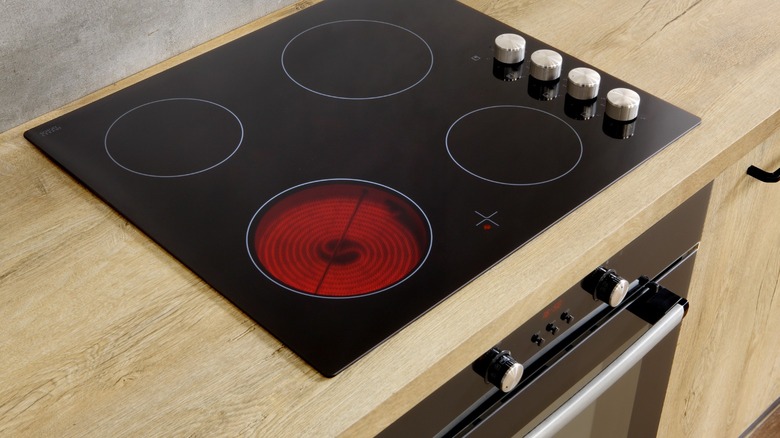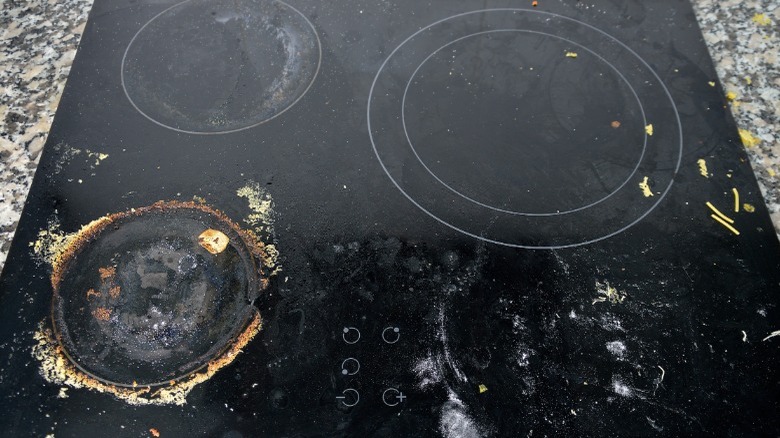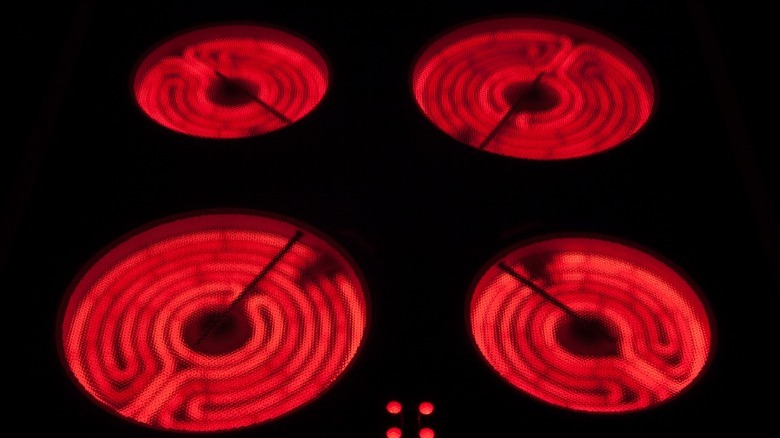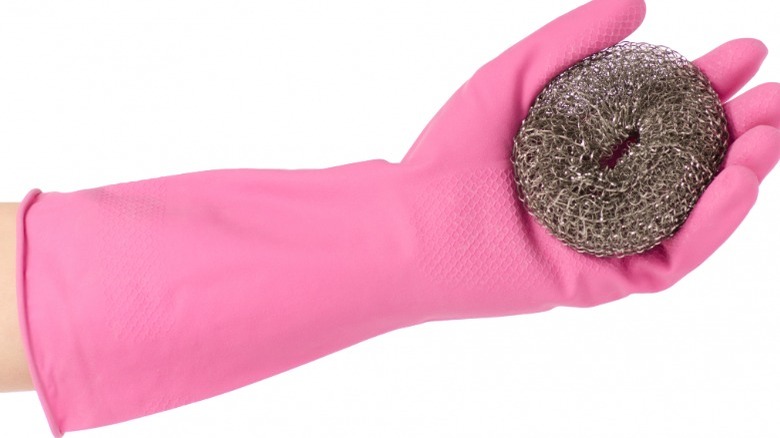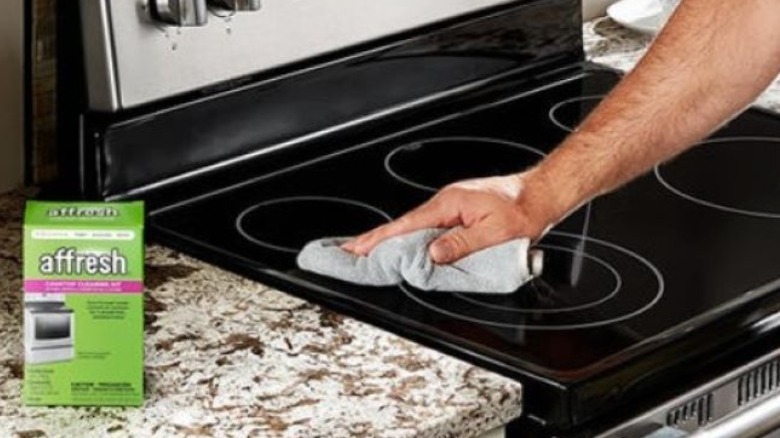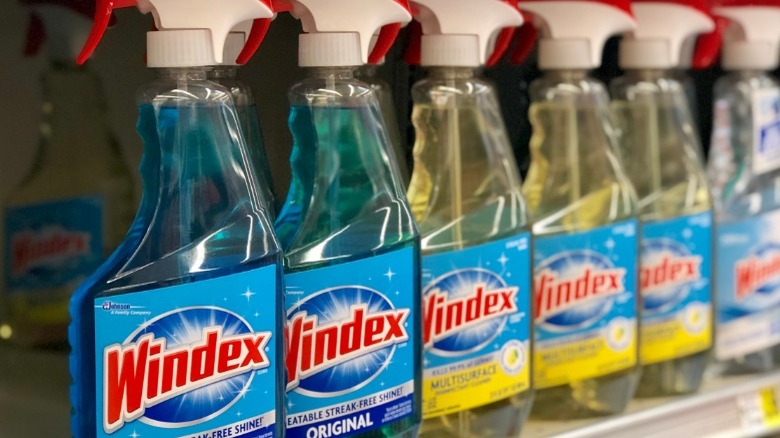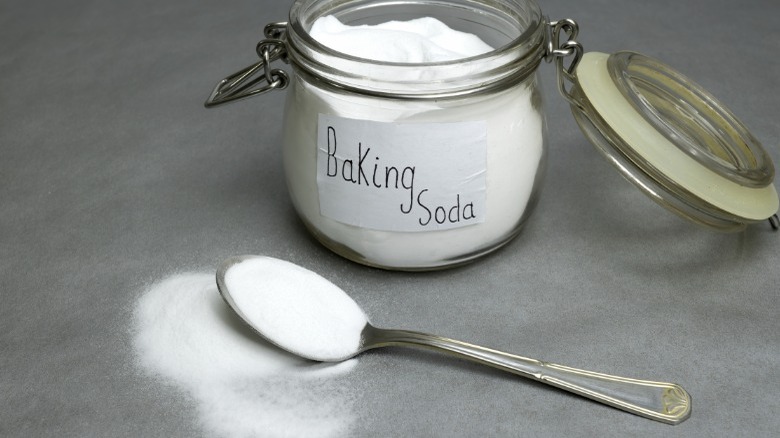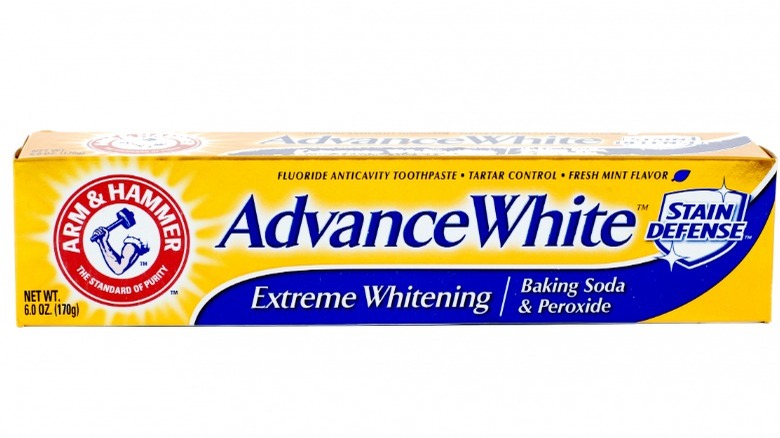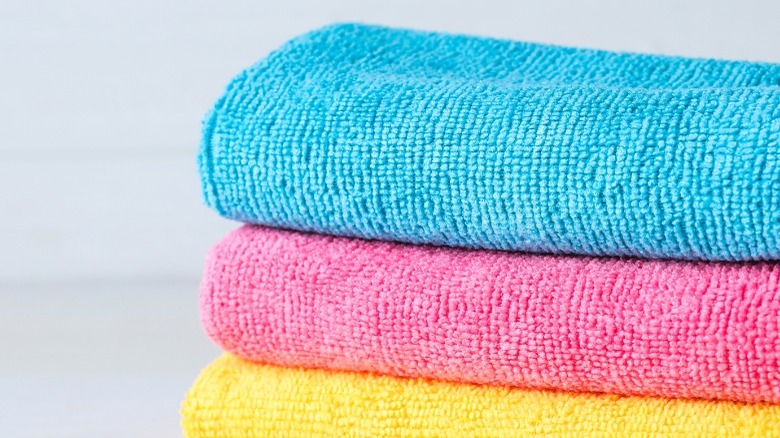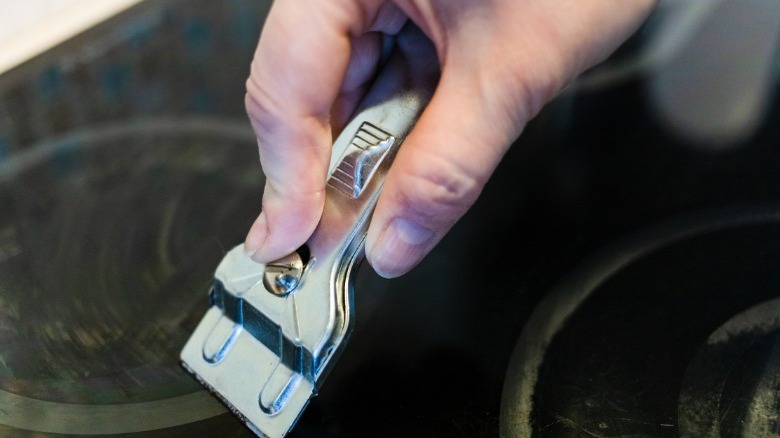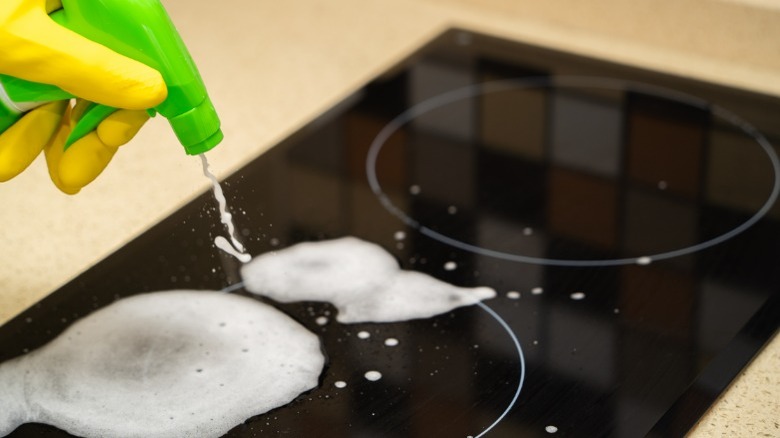The Biggest Mistakes You're Making When Cleaning Your Glass Top Stove
Ceramic glass top stoves are sleek, minimalistic, and expensive , but quickly get stained from spills and grease. And when they aren't cleaned properly, the damage can be irreversible. They're different from other stovetops because the burners are usually hidden beneath the surface, and you can't see them until they heat up and turn red. They tend to heat up faster than other kinds of stoves and can take longer to cool down. Induction glass ceramic cooktops work with magnets and electricity; they have electromagnetic coils and require special cookware that's made for them. Electric glass top stoves can be made with halogen bulbs, metal coils, or both (semi-halogen). There are a few gas ceramic glass cooktops but the burners are on top instead of being hidden beneath, so they may need to be removed for cleaning.
There's no denying the aesthetic appeal of glass top stoves but just like expensive cars, they must be handled with care. All stove tops will get full of icky stuff, but ceramic glass surfaces shouldn't be cleaned in the same ways or they can scratch and become discolored. There's a bit of a learning curve when it comes to cleaning glass top stoves, but we've got you covered. Here are some of the biggest mistakes that people make when cleaning these modern stoves, plus a few tips to make the job easier.
Letting it stay dirty
A clean glass top stove is a beautiful thing, but the pristine appearance usually doesn't last too long. There are almost always water stains, grease drops, or dried food globs on there after it's used; even tiny spatters are noticeable because the surface is so dark and shiny. And if you keep using it without cleaning the surface, that gunk accumulates, heats up, cools down...it'll be that much harder to remove and the crustiness could leave scratches when you wipe it off.
Leaving food stains on a glass top stove also affects the stove's cooking quality. Messes like this create barriers on top of the surface, which impacts how heat is transferred to cooking pots and pans. As a result, your food can cook unevenly. There's also the risk of grease stains catching fire if you're not careful. We admit that there's not always time to give a glass top stove a good cleaning right after mealtimes, but do your best to clean it as soon as possible afterward. Being vigilant about this can also extend the life of the glass top stove; these things are costly to replace.
Not waiting until it's cooled down
Glass top stoves often have heat indicators to let you know that they are still hot; look for a small, extra light near the knobs or touchpad. Attempting to clean it before the surface has cooled down could lead to burns and even fires (if you use a cloth or towel). Although we mentioned that it's harder to remove crusted-on food from a glass top stove, you still need to wait until it's safe. Even if you don't feel the heat or see the burners lit up through the glass top, the entire surface can be dangerously hot.
Another reason to hold off is unwanted fumes. That's right, those can develop if you use a cleaning product on a still-hot stove top (hot vinegar smells especially bad); the product also evaporates and won't be as effective. And if you want to speed up the cooling-down process, turn on a fan or open up the window. Don't touch the surface until the indicator light shuts off; if yours doesn't have one, read the manufacturer's manual to see how long you're supposed to wait.
Using abrasive cleaning tools
Abrasive cleaning tools like steel wool pads are great for cleaning pots and pans but should never be used on a glass top stove. That's because glass can be scratched by anything that's harder than it, including steel. So what are steel wool pads made from? Bundled-up fine metal wires (steel is a type of metal) that have abrasive edges, sold with or without cleaning agents within; steel wool is often used in place of sandpaper. Would you clean your glass top stove feel with that? We didn't think so.
Don't throw out your steel wool pads though, because you can still use them at your sink or workbench. They're also great for plugging up openings where rodents and other pests attempt to get into. Also avoid using steel wool on stainless steel, plastic, and non-stick coatings; it's too abrasive for these as well. Do yourself a favor and keep those pads and other scouring pads where they belong, away from the glass top stove; that way, no one will grab one by mistake. The same guideline applies to scrub brushes and rough scrubbing pads. You might think that these would be perfect for removing cooked-on messes from glass stove tops, but they can also leave noticeable scratches.
Not using a glass top stove cleaning product
Now you know that glass top stoves don't tolerate abrasive cleaning products and tools, so what are the alternatives? A few companies manufacture products specifically designed to clean these sensitive surfaces and you can buy them in stores or online. One is Affresh, which sells a variety of kitchen and laundry cleaning products. Its non-abrasive cooktop cleaner is made with feldspar, quartz, and citric acid; apply with a cloth and keep your hands away from your eyes when using it. The company also makes a cooktop cleaning kit that comes with a 5-ounce bottle of the cleaner, plus five cleaning pads and a yellow scraper. To use it, first remove dried and burnt-on food debris with the scraper and make a pass over the surface with a soft cloth. Next, pour the cleaner onto the scrubbing pad and smooth off the stains. This can be used once a month or as needed. A clean, dry cloth can be used in place of the pad to buff the surface to a nice shine. Amazon sells the Affresh cleaning kit for $9.99.
Weiman also sells a glass cooktop cleaning kit that includes a bottle of heavy-duty cleaner/polish, scraper, and non-abrasive cleaning pad; they also make glass cooktop eraser pads and a regular glass cooktop cleaner and polish . The cleaner/polish and pads are also sold separately. We couldn't find the ingredients in the heavy-duty cleaner because it's a trade secret, but the regular cleaner also contains quartz and citric acid. The Weiman cleaning kit was $18.98 on Amazon, but it comes with 10 ounces of cleaner and one cleaning pad with a built-in gripper.
Using glass cleaner
Glass cleaning products might seem to be a good choice for ceramic glass top stoves and cooktops, but they could have harsh ingredients and also leave streaks. And if used too often, they could also cause permanent staining. Looking at the ingredients in Windex, we see things like lauryl dimethyl amine oxide, 2-hexoxyethanol, and lauryl dimethyl amine oxide (surfactants); isopropanolamine (a solvent), fragrance, and dyes. Windex comes in blue, yellow, pink, purple, and green, BTW. It's easy to see how the dyes might cause discoloration on glass stove tops. The company does claim that the product works on glass stove tops though, but we prefer to be extra careful.
There are eco-friendly glass cleaners too, like the one manufactured by Biokleen. This also contains some hard-to-spell ingredients like tetrasodium glutamate diacetate and phenoxyethanol, but these are all plant-derived. Biokleen and Windex both contain ammonia, which is considered to be a harsh chemical; it also has a strong smell. Ammonia is added to these products to prevent streaking, but you might still see those on the glass top stove after cleaning with them.
Not using baking soda
Baking soda is a miracle product with countless baking, freshening, and cleaning applications. It's a non-abrasive, gentle cleaner that can be made into a paste with a bit of water. Start with three parts baking soda to one part water, mix with a clean paintbrush, and spread lightly in a circular motion. Give it about five minutes to break down the debris and wipe it away with clean, damp towels.
For extra cleaning power, swap out the water with some hydrogen peroxide. Be sure that it's only a 3 percent concentration since higher ones are too harsh. Or, you can sprinkle the baking soda onto the cooktop, pour the hydrogen peroxide into a spray bottle, and spritz it on. Then you can work it in with the paintbrush. For tougher stains, give the concoction a good ten minutes to work before cleaning it off; repeat the process but let it sit longer if the stains are still there. Hydrogen peroxide is safe to use around food, so you won't have to worry about that.
Not using toothpaste to remove scratches
Toothpaste keeps your breath minty fresh, but it can also be used to remove minor scratches on glass cooktops. Don't use the gel kinds for this; stick to the white paste (ones with baking soda like Arm & Hammer's and whitening toothpaste work best) and leave your toothbrush in the bathroom — it's too abrasive for this job. Apply a bit of the toothpaste onto the scratch and work it in gently with a dampened cloth with just a bit of pressure. After you've wiped away the toothpaste, check to see if it worked. If so, wipe it away and buff out the surface.
If the scratches were too deep for the toothpaste trick, all is not lost. A few scratches can make your glass top stove look beat up, but it shouldn't affect its performance. To prevent them, you can also check the undersides of your pots and pans for stuck-on crusty food that could easily leave marks. It's also wise to never rest cooking utensils, cutting boards, or other things on top of stoves because they can also make marks or start fires.
Using paper towels instead of microfiber towels
Paper towels are somewhat abrasive, so you won't want to use them to dry glass top stoves after cleaning them. Microfiber towels are made from tiny fibers and are much more absorbent – these are synthetic materials and are thinner than one human hair. Another plus: microfiber towels are positively charged so they attract grease and dirt. And since they dry so fast, bacteria have less time to grow on them.
Microfiber towels are also less expensive than disposable paper towels because they can be reused time and time again. You can buy them in bulk and keep some in your kitchen and bathrooms. Use them to work in baking soda paste, Affresh, and other storebought and homemade cleaning solutions onto your glass cooktop. Grab a fresh microfiber towel, run it under the faucet, and wipe off the cleaner; use a second one to dry the cooktop. Toss them in the washing machine and clean them just like regular towels. They're more durable than cotton and can be washed hundreds if not thousands of times.
Not using a razor blade
It goes against common sense to apply a razor blade to a glass top stove, but it's one of the best ways to remove hardened spills on glass top stoves. Razor blades work especially well on sugar-based food stains (like tomato sauce) that seem to bond with ceramic glass. You must wait for the surface to cool but can use the razor without a cleaning product. The tricks are to hold it at a 45-degree angle and not to use too much force.
If you're hesitant about using sharp, metal razor blades, there are alternatives. The Affresh glass cooktop cleaning kit comes with a plastic scraper or you can also buy one separately at a hardware store. You'll still want to be careful, even if these aren't made from metal. The edges are still quite sharp but these blades have built-in handles that make them easier to work with. And to protect your hands and fingers, just put on a pair of work gloves. You'll be amazed at how well razor blades and scrapers remove cooked-on food.
An easy way to clean glass top stoves
Vinegar is a widely-known cleaning agent so it's always a good idea to have a big bottle of it in your house. In the kitchen, it can clean and disinfect cutting boards, clean floors and countertops, and shine up your glass cooktop. You can pour it into a spray bottle and use it straight, or dilute it with water. It can also be combined with a drop of Dawn dish soap or baking soda.
The best way to use it to clean a glass cooktop is to first spray it with a 50/50 mixture of vinegar and water. Spritz it on the surface and wipe it down with a damp microfiber towel. Since vinegar is acidic, it eats away at grime and dirt. This is a good habit to get into after the stove is used each time because it prevents buildup. We know you're too busy to do this every weeknight but don't worry; just boost the vinegar with the dish soap and let it sit for 10 minutes before wiping off the stove. You can also sprinkle on baking soda and spray on the vinegar/water. This has two benefits – it looks very cool when it fizzes up and that works to break down the food particles.
Here are a few more tips for cleaning glass top stoves. Before starting, take a flashlight and shine it on the surface; this makes it easier to spot hard-to-see stains on the black surface. And if the knobs are removable (check the manual), take them off and soak them in hot, soapy water. You can do the rest of the work while they're in there, and then clean them off, dry them, and put them back on when you're done.
